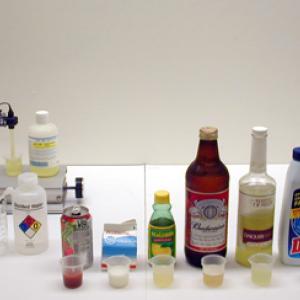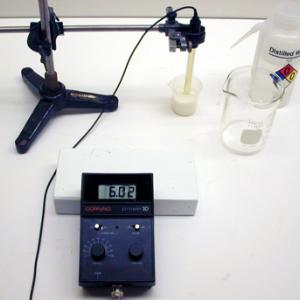College of Liberal Arts & Sciences
10B10.20 - pH of Common Liquids
Assemble the apparatus as shown. Check the batteries in the pH meter. Wash the probe tip with distilled water and then lower it into the buffer solution and recalibrate. After testing each liquid the probe must be rinsed with distilled water to maintain accuracy. Approximate pH ranges are as follows:
Daiquiri 2.7 to 2.9
Draino 8.7 to 8.8
Tomato Juice 4.5 to 4.6
Beer (Bud Light) 4.55 to 4.65
Lemon Juice 2.5 to 2.6
Mountain Dew 3.3 to 3.4
Tap Water 8.5 to 8.6
Distilled Water 6.95 to 7.05
Milk 6.6 to 6.7
Ethyl Alcohol 6.7 to 6.9
pH Buffer 7.0
Store the pH probe with a few drops of distilled water in the protective cap as the probe will be destroyed if it remains dry for extended periods.
- Curt Suplee, "Seeking balance: pH", Everyday Science Explained, National Geographic, p. 150.
- Herb Strongin, “Investigating Acids and Bases Using Litmus Paper“, Science on a Shoestring, p. 35.
- Borislaw Bilash II, “Indicators Make the pH Scale Colorful“, A Demo A Day – A Year of Physical Science Demonstrations, p. 182.
Disclaimer: These demonstrations are provided only for illustrative use by persons affiliated with The University of Iowa and only under the direction of a trained instructor or physicist. The University of Iowa is not responsible for demonstrations performed by those using their own equipment or who choose to use this reference material for their own purpose. The demonstrations included here are within the public domain and can be found in materials contained in libraries, bookstores, and through electronic sources. Performing all or any portion of any of these demonstrations, with or without revisions not depicted here entails inherent risks. These risks include, without limitation, bodily injury (and possibly death), including risks to health that may be temporary or permanent and that may exacerbate a pre-existing medical condition; and property loss or damage. Anyone performing any part of these demonstrations, even with revisions, knowingly and voluntarily assumes all risks associated with them.

